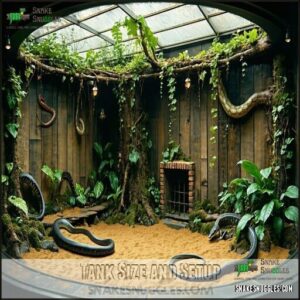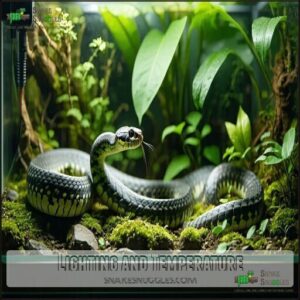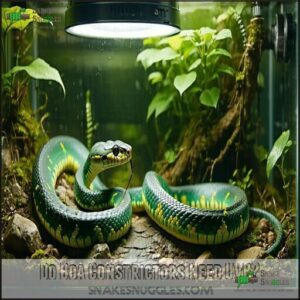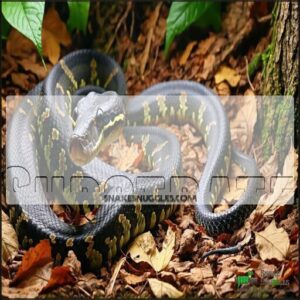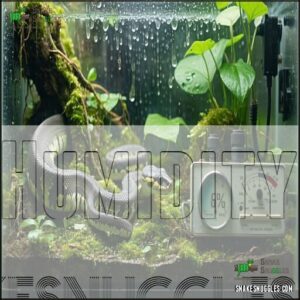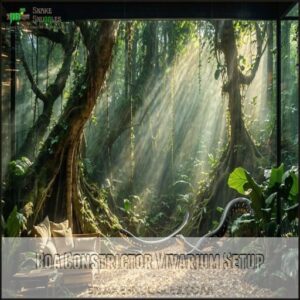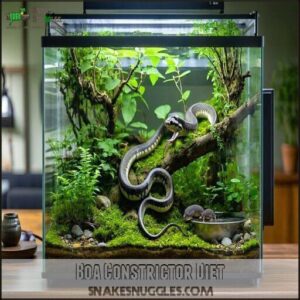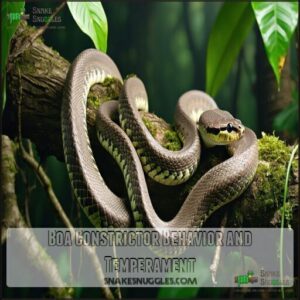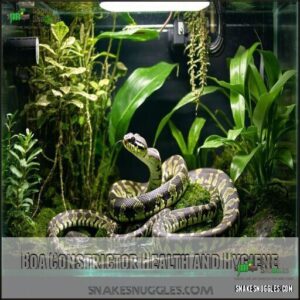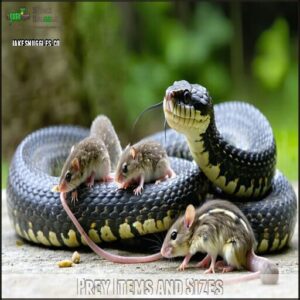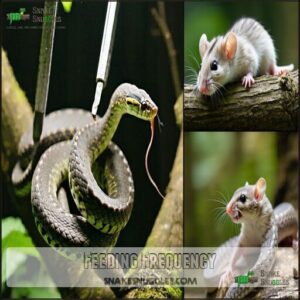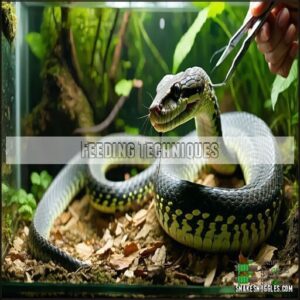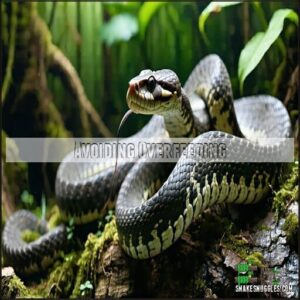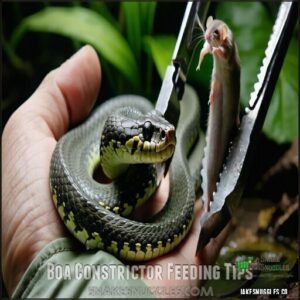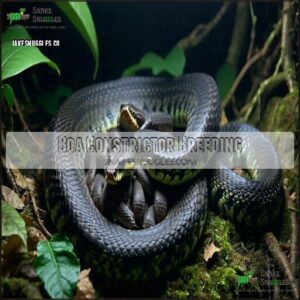This site is supported by our readers. We may earn a commission, at no cost to you, if you purchase through links.
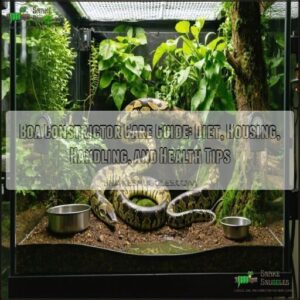
You’ll need a secure enclosure that matches its size—start with a 4-foot-long tank for smaller boas and upgrade as it grows.
Keep the temperature between 75-85°F, with a basking spot around 90°F, and maintain 50-70% humidity to mimic its natural habitat.
Feed appropriately sized prey (usually rodents) every 1-2 weeks, and provide fresh water at all times.
Handle it gently, supporting its body to avoid stress, and watch for signs of illness like wheezing or lethargy.
A clean vivarium keeps your boa—and you—happy.
Table Of Contents
- Key Takeaways
- Choosing Your Boa Constrictor
- Housing The Boa Constrictor
- Boa Constrictor Diet
- Boa Constrictor Behavior and Temperament
- Boa Constrictor Temperature and Lighting
- Boa Constrictor Health and Hygiene
- Feeding Boa Constrictors
- Boa Constrictor Breeding
- Boa Constrictor Handling and Safety
- Frequently Asked Questions (FAQs)
- Are boa constrictors healthy?
- How do you care for a boa constrictor?
- Are boa constrictors available in the UK?
- How long does a boa constrictor take to get used?
- How to choose a boa constrictor?
- How do you set up a boa constrictor?
- Do I need to handle my boa constrictor?
- What are boa constrictors?
- Do boa constrictors need enrichment?
- Are boa constrictor easy to care for?
- Conclusion
Key Takeaways
- Provide a secure enclosure with proper heating (75–90°F), 50–70% humidity, and hiding spots for comfort.
- Feed frozen-thawed prey matched to your boa’s size every 1–2 weeks, and avoid handling for 48 hours after feeding.
- Handle your boa gently and regularly to build trust, but watch for stress signs like wheezing or tight coiling.
- Keep the enclosure clean with weekly spot-cleaning and periodic deep-cleaning to prevent health issues like scale rot or respiratory infections.
Choosing Your Boa Constrictor
Choosing the right boa constrictor starts with understanding their unique traits, including species, temperament, and lifespan.
Think about your experience level and available space, as these factors will help you select a snake that suits your lifestyle.
Boa Constrictor Species and Temperament
Choosing the right boa constrictor is all about understanding its temperament and matching it to your comfort level. Boa constrictors are generally known for their docile temperament, especially when bred in captivity.
Subspecies differences can influence behavior, so it’s essential to do your research beforehand. Red-tailed boas (Boa constrictor constrictor) are strikingly beautiful but can sometimes be more defensive. In contrast, common boas (Boa constrictor imperator) are popular for their placid temperament, making them a better option for beginners.
They tolerate handling well with regular, gentle interaction. Watch for temperament variations: signs like a gaping mouth or a tight S-coil mean the snake feels threatened. While boas aren’t venomous, their constriction risks should never be ignored.
Move slowly and confidently when handling them. Boa constrictors are nocturnal and rely on their strength to hunt. Their quiet, calm behavior makes them fascinating pets—but only for those ready for the commitment!
Boa Constrictor Subspecies
When picking a boa constrictor, understanding subspecies is key. From the gentle Boa imperator to the striking red-tailed Boa constrictor constrictor, each offers unique traits.
Consider their origins and size variations before deciding. Some boas, like the Colombian Boa, are known for being beginner friendly boas.
- Geographic ranges: Central America boasts smaller boas; South American boas grow larger.
- Temperament: Imperator is relaxed; constrictor suits experts.
- Conservation concerns: Help preserve rare snake subspecies.
Boa Constrictor Appearance and Colors
Boa constrictors showcase mesmerizing subspecies colors and patterns, making them a visual marvel.
Selective breeding produces common morphs like Albino, Hypo, and Snow, each with unique pigment variations. Color genetics influence their snake melanin, creating striking boa morphs.
These snake color morphs are breathtaking and diverse.
| Morph | Primary Color | Unique Feature |
|---|---|---|
| Albino | Yellow/White | No dark pigment |
| Hypo | Light Brown | Reduced dark patterning |
| Anery | Black/Gray | Absence of red pigments |
| Snow | White | Albino + Anery combination |
Boa Constrictor Lifespan
While boa constrictors boast striking appearances, their longevity is just as impressive.
With proper care, you can expect your boa to be a long-lived companion. Their lifespan in captivity often ranges from 25 to 35 years, but with exceptional husbandry, some boas surpass 40 years—true veterans of the snake world.
Factors affecting lifespan include diet, enclosure quality, and overall health. Captive boas substantially outlive their wild counterparts thanks to consistent care.
- Key influences on boa lifespan include:
- Spacious enclosures for activity
- A varied, nutritious diet
- Stable temperatures to mimic their natural habitat
- Regular health monitoring by exotic veterinarians
Housing The Boa Constrictor
Providing the right housing for your boa constrictor is essential to keep it healthy and comfortable.
A well-designed enclosure should mimic its natural habitat, offering plenty of space, proper heating, and appropriate humidity levels.
The enclosure should also provide a comfortable environment, which is crucial for the boa constrictor’s overall health.
Tank Size and Setup
Your snake enclosure should match, or exceed, your boa’s length for comfort.
Incorporate hiding spots like cork bark and foliage for security. You can find various secure options for your boa.
Use durable materials like PVC or sealed wood to build a sturdy, waterproof snake habitat.
Add climbing branches for activity, along with a bioactive substrate to simplify cleaning and maintain a natural boa constrictor care environment.
Lighting and Temperature
Creating the perfect temperature gradient keeps your boa healthy and happy.
Use heating methods like heat lamps or ceramic emitters to maintain warmer basking spots around 88°F, with cooler areas near 78°F.
Consider purchasing a specialized heat lamp for ideal heating.
Monitor temperatures daily using reliable tools, and adjust light cycles for seasonal changes, ensuring energy efficiency while meeting lighting requirements.
Proper temperature regulation is your key to mastery in boa care.
Do Boa Constrictors Need UVB?
Providing UVB lighting isn’t essential for a Boa constrictor’s survival, but it’s a smart addition to boost health.
This extra reptile care step strengthens your boa’s immune system and appetite, meeting ideal lighting requirements for superior snake care.
Aim for a UVI of 2.0-3.0 with proper placement, as UVB helps with D3 synthesis, supports digestion, and encourages natural behavior.
Substrate
Think of substrate as your snake’s cozy carpet—perfect for comfort and functionality.
Great substrate options include:
- Cypress mulch: Excellent for moisture retention and substrate humidity.
- DIY bioactive mix: Encourages burrowing behavior, mimics nature, and simplifies cleaning frequency.
- Aspen shavings: Affordable and suits many snake enclosure setups.
Selecting the right material involves considering boa substrate options for ideal health.
Avoid substrates causing impaction, like sand, for a safer, cleaner snake vivarium setup.
Humidity
Once you’ve chosen the right substrate, it’s time to fine-tune your boa’s humidity needs.
Keep ambient humidity at 60-70% using a hygrometer for accurate humidity monitoring.
Misting the enclosure or dampening the substrate helps with shedding issues and hydration levels.
Avoid excess moisture to prevent mold and respiratory health problems, but don’t let it drop too low—balance is key!
Boa Constrictor Vivarium Setup
Think of your boa constrictor’s vivarium as a habitat masterpiece.
Balance comfort with function by focusing on these:
- Enclosure Size: Allow 8’L x 4’W for stress-free movement.
- Substrate Types: Use aspen shavings or cypress mulch for humidity control.
- Climbing Branches: Add sturdy branches for enrichment.
A well-planned terrarium setup guarantees a thriving boa habitat.
Boa Constrictor Diet
Feeding your boa constrictor correctly is essential to its health, growth, and long-term well-being.
These snakes thrive on a diet of appropriately sized rodents, and understanding their feeding schedule helps guarantee they stay healthy and active.
What to Feed
Boa constrictors thrive on a carnivorous diet including appropriately sized prey like frozen rodents, birds, and occasionally rabbits.
Proper nutrition starts with matching prey size to the snake’s body—keeping them healthy, happy, and thriving.
Always match prey size to the snake’s girth for safe feeding.
Frozen-thawed options are safer and more humane than live feeding, but respect your boa’s feeding habits. A consistent feeding routine helps promote steady growth and health.
Here’s a quick guide:
| Prey Type | Feeding Phase | Ideal Size |
|---|---|---|
| Mice | Hatchlings (newborn) | No wider than snake’s body |
| Rats | Juveniles | Slightly larger than mice |
| Birds | Adults | Similar to rat size |
| Rabbits | Large adults only | Appropriately portioned |
| Lizards | Supplemental for variety | Small and manageable |
How Often to Feed
Newborn snakes, or neonates, need feeding every 5–7 days, while juveniles eat every 10–14 days.
For adults, stick to a three-to-four-week schedule.
Always match prey size to the boa’s thickest part; oversized meals risk regurgitation.
Avoid overfeeding, as obesity harms long-term health.
Understanding constrictor feeding keeps your snake growing steadily, ensuring a proper snake diet and ideal snake feeding frequency.
How Long Can Boa Constrictors Go Without Food?
With their unique fasting physiology and metabolic slowdown, boa constrictors can endure weeks or even months without food, depending on size, age, and health.
A snake hunger strike isn’t unusual—it’s how they thrive in the wild. However, prolonged fasting in juveniles can signal health risks.
Monitor snake feeding habits closely to guarantee proper snake nutrition and avoid complications. Keeping a feeding log is essential for tracking meal sizes and frequencies.
Do Boa Constrictors Need Water?
Water isn’t optional for your boa constrictor.
Keep a sturdy, shallow snake water bowl in the enclosure to guarantee hydration. It serves multiple purposes:
- Hydration methods for drinking.
- Shedding aid to loosen skin.
- A secondary **humidity source.
- Maintains stable **snake humidity needs.
- Supports good health with clean **water quality.
Replace and clean regularly to prevent bacteria buildup.
Vitamins and Minerals
Although your boa gets most nutrients from prey, gaps can occur.
To boost reptile health, sprinkle prey with supplements occasionally, using a multivitamin supplement to fill nutritional gaps.
Calcium sources prevent deficiency symptoms like weak scales, while vitamin D3 aids calcium absorption.
Without D3, snakes can’t process calcium effectively, which is why a structured supplement schedule and proper hydration balance will keep snake health at its best.
Boa Constrictor Behavior and Temperament
Understanding your boa constrictor’s behavior and temperament is essential for proper care and handling.
These snakes are generally docile and curious, but they can get defensive if they feel threatened or stressed.
Are Boa Constrictors Good Pets?
Boa constrictors can make great reptile pets if you’re ready for their size and care needs.
Known for their calm boa temperament, they rarely strike unless stressed.
While handling risks exist, especially constriction dangers, consistent handling reduces issues.
Child safety is essential, so always supervise interactions.
Compared to other snake pet options, their long lifespan demands a solid commitment level.
Boa Constrictor Handling and Restraint
Handling a boa safely starts with preparation.
Always wash your hands to remove scents and set expectations by gently tapping its head with a soft object.
Use two hands for support:
- Behind the head to guide movement.
- Supporting the body to reduce stress.
- Avoid picking up by the tail, as it risks spinal injury.
Handle large boas calmly and wait 48 hours post-feeding or during shedding.
Boa Constrictor Aggression and Biting
A boa’s bite often stems from stress or fear, not aggression.
Look for defensive behaviors like hissing or coiling tightly. To prevent bites, use steady, gentle handling techniques and avoid sudden movements.
Handling mistakes, like startling your snake, can trigger nips. Patience and consistency in taming techniques build trust, improving your snake’s temperament and overall handling safety.
Boa Constrictor Shedding and Growth
Shedding frequency reveals your snake’s growth spurts and overall health.
Young boas shed often, outgrowing old skin like kids outgrow clothes, while adults shed every 6-8 weeks.
Watch for “stuck shed,” which can signal humidity issues. Size variation among boas means shedding patterns differ.
Proper care guarantees a smooth snake shedding process, supporting their impressive growth rate and long lifespan.
Boa Constrictor Temperature and Lighting
Keeping your boa constrictor’s enclosure at the right temperature and lighting is critical for their health and well-being.
By creating a proper temperature gradient and choosing the right lighting setup, you’ll help mimic their natural habitat and keep them thriving.
Temperature Gradient
Think of your boa’s enclosure as a spa retreat, offering temperature variety.
Set a perfect gradient by placing heat sources like lamps or mats on one side, keeping daytime temps between 80-90°F.
Use thermostat control for precision.
At night, let things cool to 70-75°F.
Regularly monitor temperatures to guarantee your snake stays comfy and their needs are met year-round.
Basking Area
A proper basking area keeps your boa happy and healthy.
Set the basking temperature to 88-90°F, using heat lamps like ceramic or halogen bulbs for an even heat source.
Place the lamps above at safe distances, creating a comfy basking location.
Use a thermostat to control warmth and maintain the temperature gradient. A thermometer guarantees accuracy, making your boa’s spot cozy and efficient!
Nighttime Temperature
Nighttime snake temperature should gently dip to 70-75°F, matching their natural habits.
This temperature drop aids their comfort without risking health. Use heating methods like heat lamps and thermostats to maintain control. Make adjustments based on seasonal changes.
Here’s how to keep it steady:
- Ideal range: 70-75°F
- Heating tools: Thermostats, ceramic heaters
- Monitor consistently
- Prevent chilling drafts
- Support nocturnal rhythms
Lighting Options
Setting up the right lighting keeps your boa comfortable and healthy.
Combine broad-spectrum lighting with heat lamps for a cozy basking spot. Use halogen flood bulbs for natural warmth, and pair them with an LED option.
Stick to a 12/12 lighting schedule to mimic daytime and nighttime rhythms.
UVB lighting isn’t mandatory, but its vitamin D3 synthesis benefits can help, especially for long-term health. Always use a mesh lamp guard to prevent burns or accidents.
UVB Lighting Requirements
Why does UVB lighting matter for your boa constrictor? It promotes healthy growth, supports vitamin D production, and aids shedding.
Look for UVB bulb types like Zoo Med Reptisun T5 HO 5.0, a common favorite in reptile supplies. Position the bulb at an ideal distance for proper intensity, ensuring maximum health impact.
A well-planned UVB setup is key in any snake care guide, helping your boa thrive comfortably. Keep lighting duration consistent—10-12 hours daily, which is crucial for proper intensity.
Boa Constrictor Health and Hygiene
Keeping your boa constrictor healthy and clean is essential for its long-term well-being and happiness.
By maintaining proper hygiene and monitoring for common health issues, you can prevent serious problems and guarantee your snake thrives, which is crucial for its overall happiness.
Common Health Problems
How can you keep your boa healthy?
Stay alert for respiratory infections, skin infections, and signs of parasites like mites and ticks.
Poor humidity or cold enclosures can cause snake diseases like scale rot or shedding issues.
Balance their diet to avoid obesity.
Regular, proactive snake veterinary care guarantees early detection of snake common health problems—your best defense against long-term issues!
Inclusion Body Disease (IBD)
Inclusion Body Disease (IBD) is a serious viral disease every boa owner should watch for.
IBD symptoms include head tremors and regurgitation, often accompanied by neurological symptoms like muscle spasms. Though there’s no IBD treatment yet, prevention is your best bet.
Here’s how:
- Quarantine new snakes immediately.
- Conduct IBD diagnosis with PCR testing.
- Regularly clean to prevent mites and infections.
- Monitor for odd behavior or signs of brain infection.
Stay vigilant!
Respiratory Infections
Respiratory infections in boa constrictors can sneak up on you, so recognizing RI symptoms like wheezing, lethargy, or clicking sounds is essential.
These often stem from low humidity, poor hygiene, or improper temperatures. Prevention methods include maintaining proper humidity levels (50-70%) and keeping enclosures clean.
One potential cause is untreated stomatitis cases. If your snake shows respiratory infection signs, seek veterinary care immediately.
Treatment options like antibiotics can restore respiratory function and stop pneumonia in snakes.
| Symptom | Cause | Prevention |
|---|---|---|
| Wheezing | Low humidity | Keep 50-70% humidity |
| Lethargy | Poor hygiene | Clean regularly |
| Clicking | Cold temperatures | Maintain warmth |
The key to managing these issues is proper care and prompt veterinary care when needed, which can significantly improve the health and well-being of your boa constrictor.
Skin Infections
Skin infections, like scale rot or blister disease, often stem from poor humidity.
Watch for signs such as red scales or blisters during your snake’s skin examination.
To treat infections:
- Identify the cause—adjust humidity levels.
- Consult a vet—antibiotics may be necessary.
- Prevent recurrence—spot-clean and monitor conditions.
Think of it as a spa day for your snake!
Boa Constrictor Hygiene and Cleaning
A clean habitat is essential for your snake’s health. Regular enclosure sanitation prevents snake mites as well as reduces risks like scale rot or mouth rot.
Spot-clean weekly and deep-cleaning every 3-6 months keeps things fresh.
- Use reptile-safe disinfectants or 3% bleach for snake vivarium maintenance.
- Replace substrate during deep cleaning to prevent bacteria buildup.
- Wash hands before and after touching the habitat.
Good hygiene also helps shedding and avoids odors—keeping both your boa and you happy, which is crucial for the snake’s health and overall well-being, ensuring a clean environment.
Feeding Boa Constrictors
Feeding your boa constrictor is straightforward but requires careful attention to prey size and feeding frequency.
Providing the right diet keeps your snake healthy, prevents overfeeding, and mimics their natural eating habits.
Prey Items and Sizes
Choosing the right prey items keeps your boa healthy and satisfied.
Always match prey to the thickest part of your snake’s body—think “just enough bulge.” Rodent prey like mice and rats works great, but adding variety with chicks or quail boosts nutritional value.
Opt for frozen vs. live prey to reduce risk to your snake, and stick to the correct snake food size to prevent choking hazards.
Reliable snake food sourcing guarantees quality and consistency.
Feeding Frequency
Through your boa’s lifecycle, feeding frequency varies dramatically with age factors.
Juvenile boas need meals every 5-7 days to fuel rapid growth, while adult boas thrive on a meal every 10-14 days, extending to 3-4 weeks for mature adults.
- Match prey size to activity level: Less active boas require smaller rodent prey
- Adjust during shedding cycle: Many boas naturally fast when shedding
- Consider health conditions: Weight and energy levels indicate if your feeding frequency needs adjustment
Feeding Techniques
Now that you’ve established when to feed your boa, mastering proper feeding techniques is your next step.
Always thaw frozen prey completely in warm water until it reaches 98-100°F—cold meals can cause digestive issues.
Use feeding tongs to offer appropriately sized prey, gently wiggling it to trigger your snake’s natural feeding response.
After meals, avoid handling for 48-72 hours to prevent stress and potential regurgitation issues.
Avoiding Overfeeding
After mastering proper feeding techniques, it’s essential to prevent obesity in your serpentine companion.
Overfeeding is a common mistake among new boa owners that can lead to serious health complications.
Your boa constrictor needs a careful feeding schedule, not endless meals.
Monitor your snake’s body condition by checking for:
- A rounded, not bulging, body shape
- Visible muscle tone when moving
- No fat rolls when coiled
- Clear alertness after digestion
- Smooth shifts between body segments
To ensure the well-being of your boa constrictor, it is crucial to maintain a healthy environment and provide appropriate care.
Boa Constrictor Feeding Tips
After managing portion control, let’s look at practical feeding techniques for your boa.
Always match prey size to your boa’s midsection thickness.
Offer frozen-thawed prey rather than live to prevent injuries and parasite transmission.
Young boas thrive on weekly meals, while adults do well eating every 10-14 days.
Don’t panic if your snake occasionally refuses food—this is normal behavior.
Consider adding vitamin supplements, especially when feeding exclusively frozen-thawed prey for ideal nutrition.
Boa Constrictor Breeding
You’ll need to prepare your boa constrictors for breeding by ensuring they’re healthy adults at least 3-5 years old, with females typically larger than males.
Once you’ve created the proper conditions, including a cooling period for females, you can expect a gestation period of 100-120 days before witnessing the remarkable birth of approximately 25 live young.
Breeding Requirements
Now that you’ve mastered feeding your boa, let’s talk about turning your pet into a parent.
Successful breeding requires females over 2 years old and males at least 18 months old, both with healthy muscle mass and fat reserves.
Maintain enclosure temperatures at 82°F ambient with a 90°F hot spot, and set light cycles to 10-12 hours daily during the March/April breeding season.
Proper humidity (50-60%) is essential for reptile breeding success.
A cooling period helps in stimulating courtship behavior.
Cooling Period for Females
The cooling period acts as nature’s calendar for your female boa’s reproductive cycle.
Typically initiated in September, this critical phase prepares her body for successful breeding.
- Reduce ambient temperatures to 75°F at night for 2-3 months
- Shorten daylight hours to 8 per day during this period
- Expect reduced or no appetite during cooling
- Resume normal temperatures one week before introducing males
This temperature cycling mimics seasonal changes, triggering the female’s reproductive system to prepare for fertilization.
Mating and Fertilization
After successful cooling, female boas release powerful pheromones that signal breeding readiness.
Males respond by performing distinctive zig-zag movements across the female’s back during courtship.
Copulation can last from minutes to several hours, with females capable of storing sperm for up to a year.
Breeding maturity occurs at 18 months for males and 2+ years for females.
Unlike most reptiles, boa constrictors are viviparous, developing embryos internally without eggs, which is a unique characteristic where they are capable of internal development.
Incubation and Hatching
Your boa constrictor’s little ones come into the world through viviparous development, not eggs.
Watch for these key stages:
- Gestation period: Lasts 100-120 days after post-ovulation shed
- Physical changes: Female stops eating during pregnancy and loses weight in her front half
- Birth process: Expect 10-65 neonates (average 25) that are immediately independent
Unlike other reptiles, these remarkable creatures skip egg-laying entirely through placental transfer.
Boa Constrictor Breeding Tips
I’ll create a more informative, engaging, and precise version of the boa constrictor breeding tips content.
When preparing for breeding season, research natural habitat cycles and replicate them for success. Breeding maturity occurs at 2+ years for females and 18+ months for males.
| Factor | Detail |
|---|---|
| Breeding Season | March/April (after 2-3 month cooling period) |
| Temperature | 82°F ambient with 90°F hot spot |
| Cooling Period | Lower to 75°F at night, 8 hours light daily |
| Mating Signs | Female emits pheromones, males perform courtship |
| Gestation Length | 100-120 days after post-ovulation shed |
| Clutch Size | 10-65 neonates (25 average) |
Don’t handle females during the last 6 weeks of gestation. Monitor for ovulation swelling 6-8 weeks after successful mating. Maintain 50-60% humidity during breeding season for viviparous reptile reproduction.
For successful snake breeding, replicate your boa’s natural habitat cycles. Make certain females are over 2 years old with good muscle mass before breeding. Introduce males one week after the female’s last meal. During the cooling period, lower nighttime temperatures to 75°F with 8-hour light cycles. Don’t handle females in the final 6 weeks of gestation.
Boa Constrictor Handling and Safety
You’ll need to master proper handling techniques for your boa constrictor to guarantee both your safety and the well-being of your snake.
Supporting your boa’s body while maintaining gentle but firm control will prevent defensive strikes, which although not venomous, can still be painful and startling.
Safe Handling Techniques
After breeding success, mastering safe handling techniques is your next step.
Always wash your hands before handling to remove food scents. Gently tap your boa with a snake hook to distinguish handling time from feeding time.
When you see calm tongue flicks, lift your boa with a secure grip, supporting its entire body. This prevents injury and keeps your boa feeling safe and comfortable.
Avoiding Bites and Con
Building on safe handling techniques, avoiding bites and constriction incidents requires keen observation.
Move deliberately when handling your boa, watching for stress signals like rapid breathing or coiling. Don’t handle after feeding or during shedding when boas are most defensive.
- Never handle your boa alone if it exceeds 6 feet in length
- Keep children supervised around all snakes regardless of size
- Always wash hands before and after handling to prevent scent confusion and ensure a safe environment for both you and your boa, promoting healthy interaction.
Frequently Asked Questions (FAQs)
Are boa constrictors healthy?
Picture a sleek, muscular predator, thriving in the wild.
With proper care, boa constrictors are remarkably healthy, but their long lifespan demands diligence—regular vet checkups, pristine enclosures, and parasite prevention are key to their wellbeing.
Regular vet checkups, pristine enclosures, and parasite prevention are essential for maintaining the health of boa constrictors.
How do you care for a boa constrictor?
Provide a spacious, secure enclosure with proper heating, humidity (60–75%), and climbing structures.
Feed appropriately sized prey every 1–2 weeks.
Handle gently, avoid stressing them, and make certain of regular spot-cleaning and monthly deep cleaning.
Are boa constrictors available in the UK?
Finding a boa constrictor in the UK is easier than spotting socks in your drawer.
Exotic pet shops, reptile expos, or reputable breeders often have them, but always check local regulations before buying.
How long does a boa constrictor take to get used?
It usually takes a boa constrictor a few weeks to get comfortable with handling and its environment.
Regular, gentle interaction, supporting its body properly, and patience help build trust and reduce stress.
How to choose a boa constrictor?
Choose a boa constrictor by considering its subspecies, size, temperament, and morph.
Look for reputable breeders, assess its health, and make certain you’re ready for its 30-year commitment and significant space, heating, and care needs.
How do you set up a boa constrictor?
Start with an 8x4x4-foot enclosure.
Use secure lids, climbing branches, and a bioactive substrate.
Maintain 60–75% humidity, provide a large water bowl, and set temperatures: 80–85°F ambient, 90°F basking.
Keep lighting subtle.
Do I need to handle my boa constrictor?
Yes, handling helps your boa stay calm and accustomed to you.
Use slow, deliberate movements and support its body.
Regular interaction builds trust, but avoid handling during shedding or after meals to prevent stress.
What are boa constrictors?
Boa constrictors are large, non-venomous snakes native to Central and South America.
They use constriction to subdue prey and can grow up to 13 feet long, known for their muscular bodies and striking patterns.
Do boa constrictors need enrichment?
Did you know snakes can recognize routines?
Boa constrictors thrive with enrichment like climbing branches, hides, and texture variety.
These activities mimic their natural habitat, keeping them active, curious, and reducing stress in captivity.
Are boa constrictor easy to care for?
Caring for boa constrictors isn’t overly complicated if you’re committed.
They need proper enclosures, consistent temperatures, and regular feeding.
With a bit of research and dedication, you’ll find they’re fairly low-maintenance, long-term companions.
Conclusion
Owning a boa constrictor might seem like adopting a scaled couch potato, but it’s all about understanding their specific needs.
With the right enclosure, proper feeding schedule, and careful temperature control, you’ll guarantee a happy, healthy snake.
Regular handling is vital for bonding and minimizing stress, but always watch for signs of illness.
This boa constrictor care guide simplifies the essentials, so you can confidently provide a safe, comfortable environment for your mesmerizing reptilian companion.
- https://www.reptifiles.com/red-tailed-boa-care/boa-species-subspecies/
- https://journals.biologists.com/jeb/article/218/14/2279/14389/Snake-constriction-rapidly-induces-circulatory
- https://www.ncbi.nlm.nih.gov/pmc/articles/PMC3061174/
- https://www.itis.gov/servlet/SingleRpt/SingleRpt?search_topic=TSN&search_value=174321
- http://www.humanesociety.org/assets/pdfs/wildlife/captive/captive-constrictor-snake-incidents.pdf


